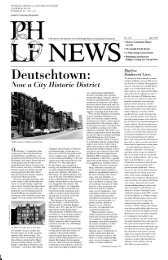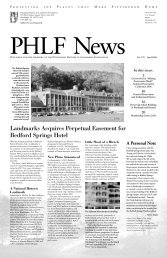Download - Pittsburgh History & Landmarks Foundation
Download - Pittsburgh History & Landmarks Foundation
Download - Pittsburgh History & Landmarks Foundation
You also want an ePaper? Increase the reach of your titles
YUMPU automatically turns print PDFs into web optimized ePapers that Google loves.
20 PHLF News February 2010 ADVOCACY COMMUNITY REVITALIZATION EASEMENTS EDUCATION & RESEARCH FARM & LANDSCAPE PRESERVATION<br />
Preservation Scene<br />
Demolished<br />
Mann’s Hotel, McKees Rocks, in 1989<br />
Mann’s Hotel (1803? – 2009)<br />
Despite efforts over the years by the Mann<br />
family, <strong>Landmarks</strong> President Arthur P.<br />
Ziegler, Jr., and Catherine Baker Knoll<br />
when she was Lieutenant Governor, a<br />
feasible plan was never found for saving<br />
the historic tavern at 23 Singer Avenue.<br />
When its doom seemed to be sealed, preservationist<br />
Mike Shealey and others developed<br />
a plan to salvage what could be saved<br />
and document the building as it was taken<br />
down. But, surprisingly, Mann’s Hotel was<br />
demolished by McKees Rocks authorities in<br />
the early hours of October 10, 2009.<br />
Mann’s Hotel was included in <strong>Pittsburgh</strong>’s<br />
Landmark Architecture: The Historic<br />
Buildings of <strong>Pittsburgh</strong> and Allegheny<br />
County, by Walter C. Kidney (PHLF 1997).<br />
Endangered<br />
Hulton Bridge<br />
During a presentation at Oakmont Country<br />
Club on December 8, 2009 to community<br />
representatives and PennDOT officials,<br />
CMU civil engineering students proposed<br />
that the Hulton Bridge of 1909 be converted<br />
to pedestrian use, promoting heritage<br />
tourism and providing a connection to the<br />
proposed Allegheny River Trail. This can<br />
only happen if an organization comes<br />
forward to assume ownership of the bridge.<br />
Based on a community survey, the students<br />
reported that 88% of citizens agreed that<br />
“funds currently set aside for demolishing<br />
the Hulton Bridge should instead be used to<br />
convert it into a pedestrian and cyclist-only<br />
crossing.” PennDOT plans to build a new<br />
bridge next to the Hulton Bridge and then<br />
demolish the historic structure in 2012.<br />
The Hulton Bridge is the oldest active truss<br />
bridge over the Allegheny River, the first<br />
major bridge designed by Allegheny<br />
County, and an Oakmont landmark.<br />
Allegheny Commons<br />
Pedestrian Bridge<br />
The decorative concrete-arch pedestrian<br />
bridge, built by the City in the early 1900s<br />
over the railroad tracks that slice through<br />
the West Common (part of the Allegheny<br />
Commons on <strong>Pittsburgh</strong>’s North Side),<br />
has been allowed to deteriorate and will<br />
probably be demolished. The Allegheny<br />
Commons Initiative (ACI), a program of<br />
the Northside Leadership Conference, and<br />
other Northside preservationists do not<br />
want the City to demolish the bridge without<br />
a plan to replace it. Ever since the park<br />
was designed in 1867, there has been a<br />
pedestrian bridge at that site, allowing<br />
people to cross safely over the railroad tracks<br />
from East Ohio Street to Lake Elizabeth.<br />
The City has funds to demolish the bridge<br />
but has not committed funds to designing<br />
and building a new pedestrian structure.<br />
The character of the Commons was<br />
further threatened when, in 2009,<br />
Duquesne Light proposed building a<br />
truck-sized crossover station on the lawn<br />
of the park’s East Commons. ACI and<br />
the community successfully defeated that<br />
plan, although final placement of the unit<br />
is still to be determined.<br />
<strong>Pittsburgh</strong> Brewing Company<br />
<strong>Landmarks</strong> and others are encouraging the<br />
owners of the historic <strong>Pittsburgh</strong> Brewing<br />
Company at 3340 Liberty Avenue to find a<br />
way to preserve some of the most architecturally<br />
significant buildings. The owners<br />
closed the <strong>Pittsburgh</strong> Brewing Company in<br />
June 2009 and subsequently announced<br />
plans to demolish the buildings. <strong>Pittsburgh</strong><br />
Brewing Company, dating from 1888 and<br />
after, is included in <strong>Pittsburgh</strong>’s Landmark<br />
Architecture (PHLF 1997) and was nominated<br />
on January 6 as a City Historic<br />
Structure.<br />
Mellon Arena<br />
The Sports and Exhibition Authority<br />
held a discussion regarding the future<br />
of Mellon Arena on January 19, to be<br />
followed by a series of public meetings.<br />
Michael Baker Jr., Inc. is completing a<br />
Section 106 Review for Mellon Arena.<br />
Designed in 1954 by Mitchell & Ritchey<br />
and completed in 1961, Mellon Arena is<br />
endangered due to the <strong>Pittsburgh</strong> Penguins’<br />
plan to redevelop the site adjacent to<br />
their new arena. In 2003, <strong>Pittsburgh</strong>’s<br />
City Council rejected efforts to designate<br />
Mellon Arena as a City Historic Structure.<br />
B. F. Jones Cottage,<br />
Cresson, PA<br />
Preservation Pennsylvania and the<br />
National Trust for Historic Preservation<br />
are helping Cresson Area Historical<br />
Association (CAHA) to raise $100,000 to<br />
save the Benjamin Franklin Jones Cottage<br />
from demolition. Designed in 1887 in<br />
the Queen Anne style and listed on the<br />
National Register of Historic Places,<br />
the cottage was owned by B. F. Jones<br />
(1824–1903), a founder of Jones &<br />
Laughlin Steel in <strong>Pittsburgh</strong>. Benjamin<br />
Henry Harrison made a speech from the<br />
balcony, accepting his party’s nomination<br />
for president. The fundraising goal is<br />
$100 apiece from 1,000 people. Questions:<br />
cressonaha@yahoo.com. Donations may<br />
be sent to Preservation Pennsylvania,<br />
257 North Street, Harrisburg, PA 17101,<br />
noting “Jones Cottage.”<br />
Todd Wilson (far left), advisor, with<br />
CMU students Gabriella Briffa, Andrew Ko,<br />
Jon Narolilli, and Christine Peters.<br />
Good News<br />
Old Stone Tavern<br />
“The public process worked,” said<br />
<strong>Landmarks</strong> General Counsel Anne Nelson,<br />
upon the successful 2009 nomination of<br />
the Old Stone Tavern on Greentree Road<br />
as a City Historic Structure. When the<br />
building owner had requested a permit<br />
to demolish the building, preservationist<br />
John DeSantis filed a City Historic<br />
Structure nomination and <strong>Landmarks</strong><br />
and others voiced their support.<br />
The Old Stone Tavern likely dates<br />
back to 1793 and was included in both<br />
of <strong>Landmarks</strong>’ architectural surveys of<br />
Allegheny County and in <strong>Pittsburgh</strong>’s<br />
Landmark Architecture (PHLF 1997).<br />
According to an article by Tony LaRussa<br />
in the <strong>Pittsburgh</strong> Tribune-Review<br />
(March 5, 2009): “Presidents George<br />
Washington and Ulysses S. Grant, and<br />
novelist Charles Dickens, might have been<br />
guests of the Old Stone Inn. The tavern<br />
might have played a pivotal role in the<br />
Whiskey Rebellion [of 1794]. . . . A 1793<br />
accounts ledger from the tavern that was<br />
discovered at the Carnegie Library of<br />
<strong>Pittsburgh</strong> indicated that among its regular<br />
customers were local farmers, businessmen,<br />
generals, and Indians.”<br />
As a result of the designation, the building<br />
owner cannot demolish the building or<br />
alter its exterior without permission from<br />
the Historic Review Commission.<br />
Hollywood Theatre<br />
Dormont’s Hollywood Theatre at<br />
1449 Potomac Avenue has been restored.<br />
Visit www.hollywooddormont.com for a<br />
schedule of classic films (and special events<br />
including dinners by Enrico’s Biscotti).<br />
The theatre seats are large and comfortable<br />
and the sound system is state-of-the art.<br />
The Art Deco theatre is splendid, affordable,<br />
and conveniently located.<br />
Beneficial<br />
Building<br />
The German<br />
Beneficial<br />
Building of 1881<br />
at 1505–07 East<br />
Carson Street<br />
received a City<br />
of <strong>Pittsburgh</strong><br />
Historic<br />
Preservation<br />
Award in 2009.<br />
South Side Local<br />
Development<br />
Company<br />
(SSLDC)<br />
accepted the<br />
award on behalf of the development team,<br />
including TREK Development Group and<br />
SSLDC as owners, Guardian Construction<br />
Management Services as general contractor,<br />
and UpStreet Architects (with Michael<br />
Eversmeyer as historic preservation consultant).<br />
Carson Street Deli, Owen’s Cleaners,<br />
and Cardinal Resources (environmental<br />
consulting) and are among the tenants.<br />
<strong>Landmarks</strong> extended a $250,000 loan to<br />
SSLDC in 2004 to help it purchase the<br />
vacant building.<br />
Worth Noting<br />
Our Public Testimony<br />
In 2009, <strong>Landmarks</strong>’ staff advocated for<br />
keeping the Carnegie Branch Libraries and<br />
the Fort Pitt Museum open; opposed the<br />
mass demolition of vacant properties on<br />
the North Side; and supported nominations<br />
for City-Designated Historic Structures<br />
for the Old Stone Tavern (see adjacent<br />
story); the former St. Mary’s Academy<br />
(1854), 340 46th Street, Lawrenceville;<br />
the Workingman’s Saving Bank (1901),<br />
800 East Ohio Street, Northside; and<br />
the Paramount Film Exchange (1920s),<br />
1727 Boulevard of the Allies, the Bluff.<br />
The first three nominations were successful,<br />
and the Paramount nomination was<br />
tentatively approved by City Council on<br />
January 20.<br />
Tear Down or Restore?<br />
After reading Paul O’Neill’s opinion piece<br />
(New York Times, December 9, 2009)<br />
suggesting that the federal government<br />
reimburse cities and towns who hire unemployed<br />
people to tear down abandoned<br />
buildings, <strong>Landmarks</strong> President Arthur P.<br />
Ziegler, Jr. replied: “wouldn’t it be better to<br />
train the unemployed to learn real skills<br />
restoring rather than the brute force of<br />
demolishing? The principle means of reviving<br />
cities and towns that has worked for the<br />
past half century is to restore them. It’s the<br />
historic architecture that attracts people.”<br />
Arthur’s opinion piece was published by the<br />
<strong>Pittsburgh</strong> Tribune-Review (January 17).<br />
Mellon Square Symposium<br />
The <strong>Pittsburgh</strong> Parks Conservancy (PPC)<br />
hosted a symposium on November 5–7,<br />
2009: “Mellon Square: Preserving,<br />
Interpreting, and Managing a Modern<br />
Icon.” PPC envisions restoring Mellon<br />
Square where possible “to recapture the<br />
strength of its original design.” It was<br />
designed by James A. Mitchell for Mitchell<br />
& Ritchey, architects, in 1953–55, with<br />
Simonds & Simonds as landscape architects,<br />
and is the earliest surviving example<br />
of an urban garage/park in the U.S.<br />
Former St. Nicholas Church<br />
Lamar Advertising, a billboard company,<br />
intends to purchase the St. Nicholas Church<br />
property on East Ohio Street from the<br />
Catholic Diocese. The property includes<br />
the former church of 1901—designated a<br />
City Historic Structure in 2001—an empty<br />
rectory, a double garage, and a grotto.<br />
Lamar intends to use the land at the site<br />
to erect billboards, but is working with<br />
The Preserve Croatian Heritage <strong>Foundation</strong><br />
and Northside Leadership Conference,<br />
who are developing plans for a National<br />
Immigration Museum in the former church.<br />
CORRECTION: On page 22 (PHLF News,<br />
No. 175, April 2009), we noted a similarity<br />
between the lone Bellefield Church tower at<br />
Fifth and S. Bellefield Avenues in Oakland<br />
and the tower of St. James Church in Paris,<br />
and implied that a church was no longer<br />
part of the Bellefield building. Members Jean<br />
Thomas and Martha Berg called to clarify<br />
that the Bellefield tower structure is a vacant,<br />
stand-alone tower, but the new structure<br />
which sits just a few feet behind the tower<br />
is known as Bellefield Towers and the<br />
Community of Reconciliation Building. Urban<br />
Design Associates Architects incorporated the<br />
Bellefield tower with the new building as a<br />
symbol to remember the former Bellefield<br />
Church and to honor the Community of<br />
Reconciliation Church, which is celebrating<br />
its 40th anniversary this year.








